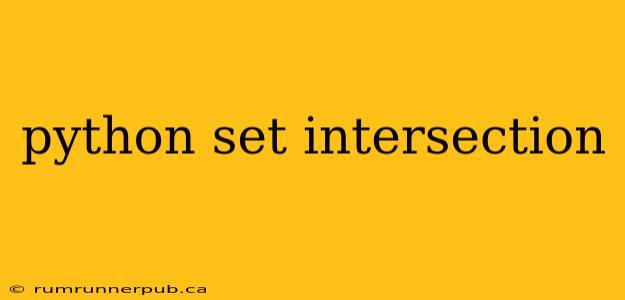Set intersection is a fundamental operation in set theory and programming, allowing you to efficiently find common elements between multiple sets. Python, with its elegant set data structure, makes this operation incredibly straightforward. This article will explore Python's set intersection functionality, drawing upon insightful questions and answers from Stack Overflow, and augmenting them with practical examples and explanations.
Understanding Set Intersection
The intersection of two or more sets is a new set containing only the elements that are present in all the input sets. Think of it as finding the overlap.
Example:
Let's say we have two sets:
set1 = {1, 2, 3, 4}
set2 = {3, 4, 5, 6}
The intersection of set1 and set2 would be {3, 4}, as these are the only elements present in both.
Python's intersection() Method: The Core Functionality
Python provides a built-in intersection() method for sets, making the process incredibly simple.
set1 = {1, 2, 3, 4}
set2 = {3, 4, 5, 6}
intersection_set = set1.intersection(set2)
print(intersection_set) # Output: {3, 4}
This code snippet directly utilizes the intersection() method. The result is a new set containing only the common elements. Importantly, the original sets remain unchanged.
Stack Overflow Inspiration: Many Stack Overflow questions revolve around efficiently finding intersections of multiple sets. For example, a question might ask about the optimal way to find the intersection of three or more sets. The answer often points to the use of intersection() with multiple arguments, which is highly efficient:
set1 = {1, 2, 3}
set2 = {3, 4, 5}
set3 = {3, 6, 7}
intersection_multiple = set1.intersection(set2, set3)
print(intersection_multiple) # Output: {3}
``` *(Inspired by numerous Stack Overflow questions regarding multiple set intersections)*
## Alternative Approaches: `&` Operator
Python offers a more concise way to achieve set intersection using the `&` operator:
```python
set1 = {1, 2, 3, 4}
set2 = {3, 4, 5, 6}
intersection_set = set1 & set2
print(intersection_set) # Output: {3, 4}
This operator provides the same functionality as intersection(), but with a more compact syntax. This is frequently seen and discussed in Stack Overflow solutions for brevity and readability.
Real-World Applications
Set intersection finds practical applications in various scenarios:
- Data Analysis: Identifying common elements in datasets. For example, finding users who have purchased both product A and product B.
- Database Management: Finding records that satisfy multiple criteria.
- Web Development: Determining overlapping user groups or features.
- Machine Learning: Finding common features between different datasets.
Example: Data Analysis
Imagine you have two sets representing users who subscribed to different newsletters:
newsletter_A = {"Alice", "Bob", "Charlie", "David"}
newsletter_B = {"Bob", "David", "Eve", "Frank"}
common_subscribers = newsletter_A & newsletter_B
print(f"Users subscribed to both newsletters: {common_subscribers}") # Output: Users subscribed to both newsletters: {'Bob', 'David'}
Conclusion
Python provides powerful and efficient ways to perform set intersection. Understanding both the intersection() method and the & operator allows for flexibility and conciseness in your code. By leveraging the wisdom gleaned from Stack Overflow and applying it to practical scenarios, you can effectively harness the power of set intersection for diverse programming tasks. Remember to consult Stack Overflow for more advanced scenarios and edge cases, and always strive for clear, efficient, and well-documented code.
